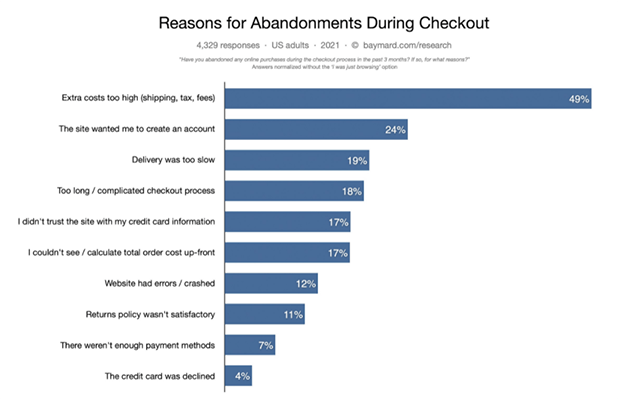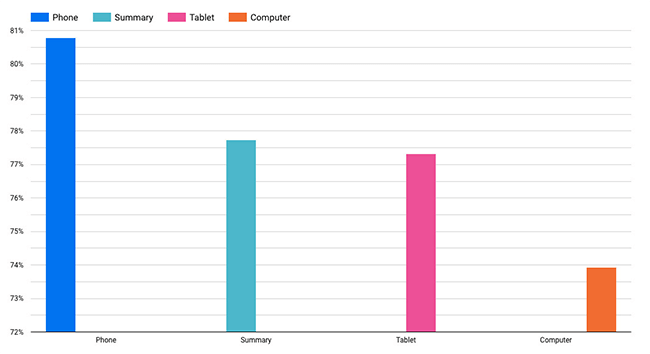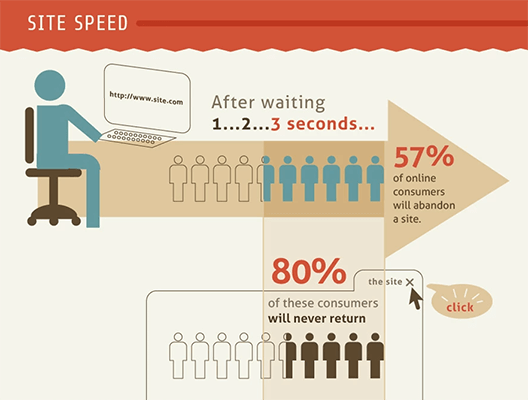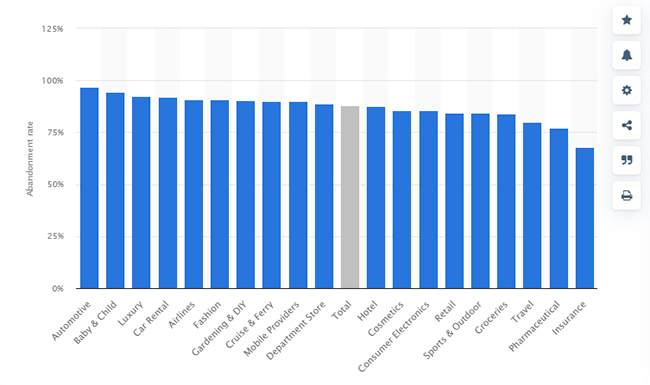25+ Shopping Cart Abandonment Statistics For 2024
As a marketer, nothing’s quite as painful as seeing customers go through your entire sales funnel only to abandon their shopping carts at the last minute.
But by looking at the latest shopping cart abandonment statistics, you’ll have an idea of why this happens and how it can affect your business.
Even better, you’ll have the information you need to make changes to your strategy to improve your chances of closing a sale.
With all that said, here’s a roundup of the best shopping cart abandonment statistics to boost your return on investment (ROI).
Editor’s picks
- Brands can lose $18 billion due to cart abandonment. (Dynamic Field)
- Extra costs are the main reason why users abandon their carts. (Baymard)
- The average abandonment rate is 69.80%. (Baymard)
Shopping cart abandonment ROI statistics and facts
Online retailers can lose a lot of money due to cart abandonment. In this section, you’ll learn just how much of an impact shopping cart abandonment has on a business. Plus, there’s information here that’ll show you that cart abandonment doesn’t necessarily mean lost sales.
Brands can lose $18 billion due to cart abandonment.
Yes, businesses can lose as much as $18 billion in yearly sales revenue thanks to shopping cart abandonment according to Forrester Research (via Dynamic Yield). And it’s possible for that number to increase to $4 trillion in succeeding years.
That’s why it’s so important to address shopping cart abandonment. It’s something that the ecommerce industry can no longer afford. If you’re an online seller of goods and services, you should create an abandonment reduction strategy.
Source: Forrester Research (via Dynamic Yield)
Using retargeting ads can get you an ROI of 1,300%.
Retargeting ads show users products or services that they’re personally invested in. That’s why it’s the best way to bring back qualified leads to your sales pages.
There are brands that already do this. In one instance, Zendesk was able to get an ROI of 1.300% thanks to retargeting ads.
So even when people abandon their carts, you can use retargeting ads to reignite their interest in your brand and get them back to where they left off.
Source: Growth Badger
UK retailers are losing out on £18 billion in sales due to cart abandonment.
Shopping cart abandonment isn’t just a problem in the US. Even UK retailers are losing out by as much as £18 billion in sales because of it.
This is because UK shoppers are into the habit of online window shopping — or adding items in their shopping cart but dropping out before completing the sale. Brits tend to abandon carts with almost £30 worth of goods every month.
The most abandoned products in the UK include women’s knitwear, leather goods, women’s lingerie, headphones, watches, women’s sportswear and skirts, books, men’s trousers, and women’s tops and shirts.
Source: Barclaycard
Shopping cart abandonment doesn’t mean lost sales.
According to Deborah Goldring, associate professor of marketing at the Stetson University’s School of Business Administration, cart abandonment doesn’t necessarily translate to lost sales.
She said that there is also the phenomenon of near-purchase activity where customers use the shopping cart as a shopping list. Customers do this to save items for a later time. Or they use shopping carts to save price information and do shipping comparisons.
Sometimes, customers also shop online but choose to purchase the items in-store.
Source: CMS Wire
Shopping cart abandonment user behavior statistics
Consumers have different reasons why they choose to abandon their shopping carts. And the key to getting better conversion rates is understanding why these people choose to leave in the first place.
Here you’ll find the most common reasons why people leave the checkout page and what you can do to address them.
Extra costs are the main reason why users abandon their carts.
A survey of more than 4,000 consumers that Baymard conducted was able to determine the main reason why people abandon their carts. A whopping 49% of respondents said that they found extra costs like shipping, tax, and miscellaneous fees too high.

24% of respondents said that they bailed on checkout because they were being asked to create an account to complete the transaction.
Other notable reasons include a complicated checkout process, couldn’t find the total upfront cost, not having enough payment options, and declined credit cards.
Most of these issues can be addressed by making tweaks to your e-commerce site though. So keep these reasons in mind when you update your checkout pages.
Source: Baymard
Mobile users tend to abandon shopping carts at a higher rate.
The shopping cart abandonment rate is worse for mobile users than it is for tablet and desktop/laptop users. According to Barilliance, the abandonment rate on phones is 80.79% in 2019.

That’s huge considering that desktop users only have a 73.93% abandonment rate.
To compensate for this, you can try optimizing your online store for mobile devices, keeping the most important details of the page above the fold, improving the user experience, and making your product pages as concise as possible.
Source: Barilliance
Note: Not happy with your current ecommerce platform? Check out our comparison of the best ecommerce platforms to build your online store.
57% of online customers will leave if a page doesn’t load in 3 seconds.
If your website—including the checkout page—doesn’t load in 3 seconds, there’s a good chance that people will leave your site. The dropout rate is as high as 57%.
To make matters worse, 80% of those potential customers will never go back to your site.

On the opposite end of the spectrum, coupons and discount codes will help boost a business. Half of US-based customers will use a coupon code. And 4% will even feel gratitude for getting a coupon or discount.
Source: Voucher Cloud
Websites that are difficult to navigate lead to cart abandonment.
Michelle Abdow, the president of Market Mentors LLC, stated that a site that’s difficult to navigate frustrates customers which leads to cart abandonment. Some of the factors that make a site difficult to browse through include broken links, too many product categories, slow loading times, and poor site organization.
To fix this, businesses can conduct a comprehensive site audit to find out where the problems lie.
Source: Forbes
44% of UK consumers abandon carts if their favorite payment method is unavailable.
A new study shows that UK customers will abandon their carts if they don’t find their favorite payment method during checkout.
For millennials (or those born between 1980 and 1993), the abandonment rate increases to 51%. Gen Z customers (born 1994 to 2001) have an abandonment rate of 48%. These two generations are the most active when it comes to online shopping.
That’s why retailers need to add more payment methods else they miss an opportunity to close sales.
Source: IT Pro Portal
Users use cart abandonment as a form of retail therapy.
While cart abandonment can be frustrating for the e-commerce industry, it’s therapeutic for consumers, especially during the pandemic. Because of the high unemployment rate in 2020, online window shopping became the new form of retail therapy.
Instead of going to the mall where people have to drive to places, online retailers are available 24/7 and can be done safely from the comfort of home. It’s a safer way to get the same fix.
Some people describe the process as a form of relaxation, a novelty, an insomnia activity, and a hobby.
Source: Vice
50% of shoppers will abandon shopping carts if delivery options aren’t satisfactory.
50% of shoppers said that they abandoned their shopping carts because the delivery choices being offered by the retailer are unsatisfactory or did not meet their needs.
And it does not stop there. 60% said that they’d buy the same or a comparable product from another retailer who did offer the kind of delivery choices that they’re looking for.
To avoid that problem, you’d want to make sure that your product delivery range is both wide and well-supported so that your customers have the most options.
Source: SmartCompany
Shopping cart abandonment rate statistics
This set of shopping cart abandonment rate statistics will give you a better idea of just how many consumers leave before buying products. It will also tell you which industries are most likely to have higher abandonment rates.
The average abandonment rate is 69.80%.
Baymard went over 44 different studies on abandonment rates. And when they calculated the average rate of shopping cart abandonment, it found that it’s actually 69.80%
Source: Baymard
Barilliance puts the average abandonment rate at 77.24%.
You’ll find different figures online as to what the average shopping cart abandonment rate is. But according to Barilliance, the rate is 77.24% as of 2021. It did note, however, that some sources place it as high as 80% and as low as 55%.
In comparison, Barilliance found that 2021’s rate is slightly lower than what it was back in 2017 which is 78.65%.
What this means for business owners is that over a third of shoppers don’t go through with the sale and abandon their online shopping carts instead.
Source: Barilliance
The automotive industry has the biggest abandonment rate.
According to Statista, the automotive industry has the biggest abandonment rate as of March 2020. Its rate is really high at 96.88%.

Other industries with high abandonment rates include baby and child (94.36%), luxury (92.61%), car rental (92.04%), airlines (90.91%), fashion (90.68%), gardening and DIY (90.34%), and cruise and ferry (90.13%).
Source: Statista
Cart abandonment rates went higher since Covid-19 started.
Amperity VP Jordan Elkind said in an interview that recent analysis showed that customers created 46.8% more shopping baskets since the start of the pandemic compared to the previous year.
During the same period, cart abandonment rate increased to 94.4%. That’s a big leap from the previous year’s abandonment rate of 85.1%.
On a related note, the digital shopping platform ShopStyle noticed an increase in its shoppers’ use of the favorite button. Favorites are up by 392%.
Source: Today
Shopping cart abandonment business statistics
How are businesses coping with their abandonment rates? And are there technologies that could help reduce it?
Businesses know all too well how much cart abandonment can hurt them. That’s why they’re utilizing technology to improve their numbers.
This section will show you how online retailers are trying to combat high abandonment rates.
JCPenney dropped cart abandonment by 18% using AI.
After JCPenney deployed its predictive AI, the company saw its abandonment rate drop by as much as 18%. The AI technology delivered positive results by bringing real-time, targeted engagement.
JCPenney worked with Metrical to implement its AI technology to improve customer experience. Thanks to that, new cart creation increased by 40% and it saw a 10% improvement in revenue on targeted visits.
More importantly, JCPenney saw an 18% reduction in cart abandonment.
Source: Retail Info Systems
45% of cart abandonment emails are opened.
Moosend’s database shows that when brands send out cart abandonment emails, 45% of them are opened. And out of the opened emails, 21% of them received click-throughs.
What’s even more impressive is that of those who engaged with the content of cart abandonment emails, half of them completed their purchases.
Source: Moosend
Navis released an integrated cart abandonment solution.
Navis released an integrated cart abandonment solution that connects the industry’s most popular website booking engines with its Navis CRM.
What that means for its hotelier partners is that when guests exit their website, a new shopping cart abandonment application pushes these leads into Navis where it sends automatic follow-up emails and allows reservation sales teams to act on it.
During the pilot program, their clients received an average abandonment lead conversion rate of 25 to 40%.
Source: Navis (via PR Newswire)
Online retailers are looking for new solutions for cart abandonment.
Online retailers are investing time and resources to address cart abandonment. Specifically, they’re looking for ways to speed up and optimize the checkout process.
One of the popular solutions being looked at is to implement one-click checkout methods similar to what Amazon is currently using.
They’re also looking into integrating digital wallets like Apple Pay. Based on research, 50% of the global population will use digital wallets by 2024 and that contactless payment transactions will exceed $1.5 trillion.
If your business is struggling, try looking into one of these solutions.
Source: Forbes
Strong Customer Authentication leads to cart abandonment.
Tests conducted by Microsoft show that strong customer authentication or SCA leads to customers abandoning their purchases at high rates.
SCA is a two-step verification process for all European online purchases. What this means for customers is that they’ll need to provide more than one proof of identity to buy a product like a password, a fingerprint or facial scan, or access to their phone.
The tests confirm that users don’t like the challenges presented by SCA and that it leaves them confused. There are also instances when SCA is poorly implemented.
What can we learn from this? Do not overcomplicate the checkout process. When consumers struggle, they tend to drop everything and leave. You don’t want that.
Source: Finextra
Google can add items to shopping carts.
Not only can Google add items to shopping carts, it intentionally does it to verify the price provided by online merchants.
Google confirmed this via SEO Roundtable. To quote the search engine giant, “We use automated systems to ensure consumers are getting accurate pricing information from our merchants. This sometimes leads to merchants seeing abandoned carts as a result of our system testing whether the price displayed matches the price at checkout.”
This is part of Google’s crackdown on Google Merchants that violates the site’s pricing policies. But what that means for online retailers is that they could find abandoned carts that aren’t organic.
Source: SEO Roundtable
“Buy Now, Pay Later” installment payment option helps reduce abandonment rate.
Fiserv, a financial services technology solution, introduced a “Buy Now, Pay Later” installment payment option in an effort to help its network of online stores lower their cart abandonment rate.
This is a great solution for consumers who lack access to credit cards or for those looking for a way to budget their income. It also calls back to one of the earlier statistics about adding as many payment options to lower your cart abandonment rate.
Source: IBS Intelligence
Shopping cart abandonment statistics sources
Conclusion
Ecommerce stores lose a lot of money because of cart abandonment. But if you’re losing customers during checkout, know that it’s not the end of the world.
There are many things you could do to address the issue. As suggested by experts, you could do a comprehensive site review to see if there are pain points for your customers that are preventing them from converting.
Is your site loading slowly? Are you requiring customers to enter too much information? Do you have the right payment and shipping options?
These are just some of the things you could look into.
Also, studies show that consumers respond well to email follow-ups. So you could try sending abandonment cart emails to try and convert part of those who have left the conversion process.
Finally, if you want a quick and easy way to calculate your return on investment, check out our free ROI calculator.
Looking for more statistics? Try one of these articles:
